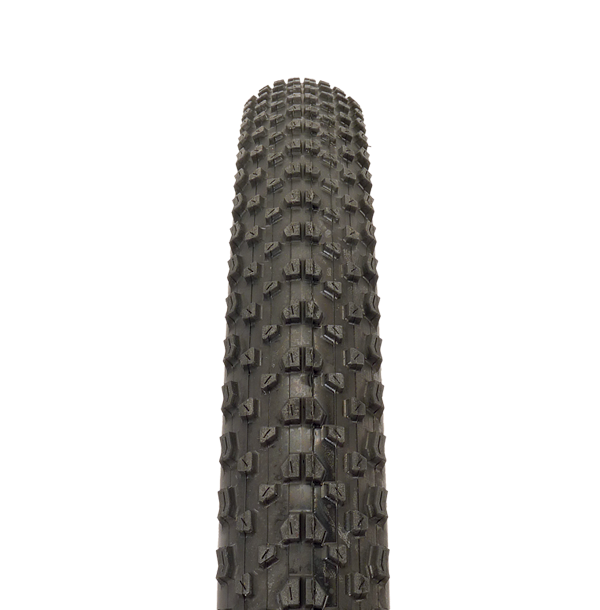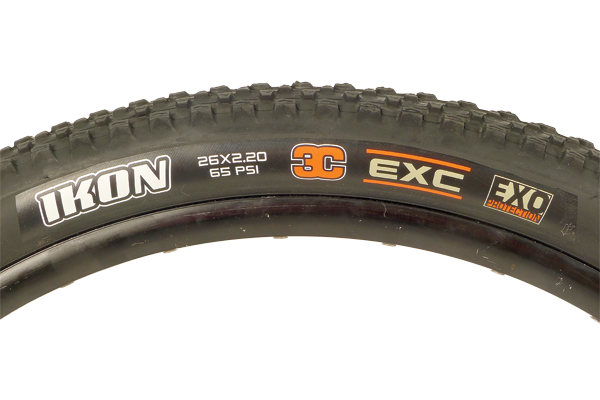Maxxis Ikon EXO
 There’s no disputing that Maxxis are one of the most dominant players on the Australian MTB tyre scene; they seem to have a tread pattern for just about every condition, and the prices have always represented great value for money. Having said that, they’ve been losing a bit of ground lately to other brands offering more high-tech casings; especially those offering fast, lightweight but durable tyres that work well with or without tubes. The Ikon is aimed squarely at reversing that trend, with a totally new tread pattern and enough technology (and associated acronyms) to keep even the most diehard rubber geek happy.
There’s no disputing that Maxxis are one of the most dominant players on the Australian MTB tyre scene; they seem to have a tread pattern for just about every condition, and the prices have always represented great value for money. Having said that, they’ve been losing a bit of ground lately to other brands offering more high-tech casings; especially those offering fast, lightweight but durable tyres that work well with or without tubes. The Ikon is aimed squarely at reversing that trend, with a totally new tread pattern and enough technology (and associated acronyms) to keep even the most diehard rubber geek happy.
Offered in both 26 and 29-inch formats, our test sample was the Ikon 2.2, 26 eXC/3C/EXO. That translates as a 2.2-inch wide, 26-inch diameter tyre with a lightweight 120tpi casing (eXC), a triple rubber compound consisting of different base rubber, centre, and edge block hardness (3C), and with the new EXO protection reinforced sidewalls (EXO). Phew!
On a 19mm (internal) rim at 30psi they measured 55mm across the casing and 51mm across the tread, so the bag size is just a fraction under the claimed 57mm mark but it’s still quite big. It’s billed as a fast but grippy tyre for XC and trail use, and has a claimed weight of 540g (the actual weights were 525 and 545g), which is pretty darn light for this size and type of tyre. All the included technology means they are a premium tyre, and with a retail price of $130 they cost a fair bit more than the standard Maxxis models. You’ll also find more affordable versions starting from $40 (wire bead) and without EXO protection the folding eXCeption tyre sells for $65.

Although not specifically billed as a tubeless ready tyre, we ran our Ikons with a Stan’s conversion kit and sealant. We had no trouble getting them to inflate and seat, and they’ve held air well throughout the test period. In the past we’ve been reluctant to run Maxxis eXCeption tyres without tubes, as the paper-thin sidewalls are very prone to cutting on sticks or sharp-edged rocks. The EXO sidewalls have an extra layer of fabric added to both boost sidewall stiffness when run at low air pressures and, in particular, to make them more cut resistant. Whilst we do know someone who managed to put a sharp stick through an Ikon sidewall on the second ride, ours have held up well to the constant scraping and abrasion of our rocky home trails. They’ve certainly faired much better we’d typically expect.
Unlike some other multi-compound offerings, the difference in tread between centre and edge blocks is very distinct. The hard centre tread is designed to wear well while the soft edge knobs are meant to offer some extra cornering traction. In use we’d say this holds pretty true. Whilst the relatively low knob height will ultimately limit their lifespan, our Ikons are still looking good through the centre track but are showing some feathering on the softer outside blocks caused by abrasive sandstone trails.
Ikonic Performance
Let’s be clear about one thing from the outset; these are not mud tyres; in wet conditions they clog easily and struggle to gain traction. If the trails are dry to slightly damp they work very well, particularly if the surface is either hardpack or groomed forest soil. Although the separated centre tread doesn’t roll quite as quickly as something more continuous (like the Crossmark for example), they have much better straight line traction – both in acceleration and braking – and they’re still surprisingly fast for a ‘knobby’ tyre.

Their decent air volume allows you to run pressures in the high 20s without major risk of rim dings, and it offers a much more compliant ride than you’ll get out of skinnier rubber. The rounded profile combined with evenly sized and spaced tread blocks makes for extremely predictable levels of grip, all the way from fully upright to the limit of cornering traction and beyond. They have good but not great edge traction, and beyond their limit they drift in an incredibly controlled fashion.
Our first ride on them was in the buff and flowing trails of Wingello, and deliberately pushing the back end around tight corners was so much fun it became almost mandatory—we were left wishing for spare legs so we could just keep on sliding! This trait is a bit of a double edged sword however, because whilst rear wheel steering is a lot of fun, we’d prefer our front tyre to dig in and hold a line when push comes to shove, and the Ikon doesn’t quite have enough bite. For marathon and moderate XC riding it’s perfectly fine, but for more aggressive trail riding we’d prefer to pair an Ikon on the back with something like an Ardent up front.
Overall, the Ikon is a welcome addition to the ever-growing Maxxis line-up, especially if you want a dry conditions rear tyre that rolls quickly, grips predictably and loves being thrown though the twisties. It’s relatively light and tough, works well with or without tubes, and their volume adds a degree of compliance that’s always welcome on short travel bike. It may not be the cheapest tyre in the Maxxis range, but it’s well deserving of its price and is likely to become a favourite for many cross-country and trail riders.
BikeCorp www.bicorp.com.au


 There’s no disputing that Maxxis are one of the most dominant players on the Australian MTB tyre scene; they seem to have a tread pattern for just about every condition, and the prices have always represented great value for money. Having said that, they’ve been losing a bit of ground lately to other brands offering more high-tech casings; especially those offering fast, lightweight but durable tyres that work well with or without tubes. The Ikon is aimed squarely at reversing that trend, with a totally new tread pattern and enough technology (and associated acronyms) to keep even the most diehard rubber geek happy.
There’s no disputing that Maxxis are one of the most dominant players on the Australian MTB tyre scene; they seem to have a tread pattern for just about every condition, and the prices have always represented great value for money. Having said that, they’ve been losing a bit of ground lately to other brands offering more high-tech casings; especially those offering fast, lightweight but durable tyres that work well with or without tubes. The Ikon is aimed squarely at reversing that trend, with a totally new tread pattern and enough technology (and associated acronyms) to keep even the most diehard rubber geek happy.

